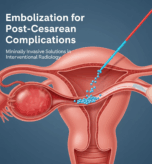Safe & Proven Embolization for Post-Cesarean Complications
Childbirth is a beautiful experience. However, for some mothers, recovery after a post-cesarean delivery can bring unexpected complications. Issues such as heavy bleeding, pelvic pain, or infections can feel overwhelming. Traditionally, surgery was the only option. Today, thanks to advances in interventional radiology, a safe and non-surgical solution called embolization for post-cesarean complications offers hope and faster recovery.
What Are Post-Cesarean Complications?
After a cesarean section, some women may face complications like:
- Severe bleeding (postpartum hemorrhage)
- Uterine artery pseudoaneurysm (a weak spot in a blood vessel)
- Infections or delayed healing
- Chronic pelvic pain
These post-cesarean complications can affect both health and emotional well-being. Understandably, many mothers worry about the possibility of more surgery. This is where embolization for post-cesarean recovery comes in as a safer, proven option.
What Is Embolization?
Embolization is a minimally invasive procedure performed by an interventional radiologist. Instead of large incisions, the doctor makes a tiny puncture in the skin. Through this opening, a thin catheter is guided into the blood vessels. Special materials are then used to block abnormal or damaged vessels that are causing post-cesarean complications.
As a result, bleeding stops, pain decreases, and recovery begins faster. Importantly, embolization often preserves fertility, making it a compassionate choice for young mothers.
Why Choose Embolization After a Post-Cesarean Delivery?
Compared to traditional surgery, embolization for post-cesarean complications provides several benefits:
- Non-surgical: No major cuts or stitches.
- Safe: Performed under image guidance for accuracy.
- Faster recovery: Most women return home within 24–48 hours.
- Less pain: Minimally invasive techniques reduce discomfort.
- Proven effectiveness: High success rates in controlling bleeding and complications.
In addition, embolization lowers the emotional and physical stress linked with repeat surgeries.
The Procedure: What to Expect
Many patients feel anxious before treatment. To ease your mind, here is what usually happens:
- The doctor applies local anesthesia, so you stay comfortable.
- A small catheter is inserted, usually through the groin or wrist.
- Using live imaging, the radiologist navigates to the affected blood vessel.
- Tiny particles or coils are released to stop the bleeding or repair the vessel.
- The catheter is removed, and the puncture site is bandaged.
The entire procedure usually takes one to two hours. Most mothers rest for a short time afterward and then return home the same or next day.
Emotional Reassurance
We understand that facing a post-cesarean complication after childbirth can be frightening. However, knowing that a safe, less painful, and proven alternative exists can bring relief. Embolization not only treats the complication but also helps restore confidence in your recovery journey.
When to Seek Medical Help
If you experience heavy bleeding, pelvic pain, or unusual symptoms after a cesarean, do not wait. Contact your doctor immediately. Early treatment can prevent serious complications and protect your long-term health.
Conclusion
Post-cesarean complications do not always mean repeat surgery. With embolization, mothers now have access to a safe, minimally invasive, and effective treatment. It controls bleeding, reduces risks, and supports faster healing — all while preserving your future health and fertility.
Want compassionate and advanced care? Learn more about post-cesarean embolization options with Dr. Vrishit Saraswat
Helpful Resources:
FAQs About Post-Cesarean Embolization
Q1. What are the complications of post-embolization?
Embolization is generally safe, but like any medical procedure, mild complications can occur. Some women may experience fever, mild pelvic pain, or temporary changes in menstrual cycles. Serious complications are rare when performed by an experienced interventional radiologist like Dr. Vrishit Saraswat.
Q2. Does embolization have side effects?
Yes, minor side effects may include cramping, fatigue, or a low-grade fever for a few days after the procedure. These usually settle with rest and medication. Long-term side effects are uncommon, and most women recover fully without major issues.
Q3. What is the success rate of embolization?
Embolization is highly effective, with success rates of 85–95% in controlling bleeding after a cesarean section. Many women avoid hysterectomy and preserve their fertility thanks to this minimally invasive treatment.






